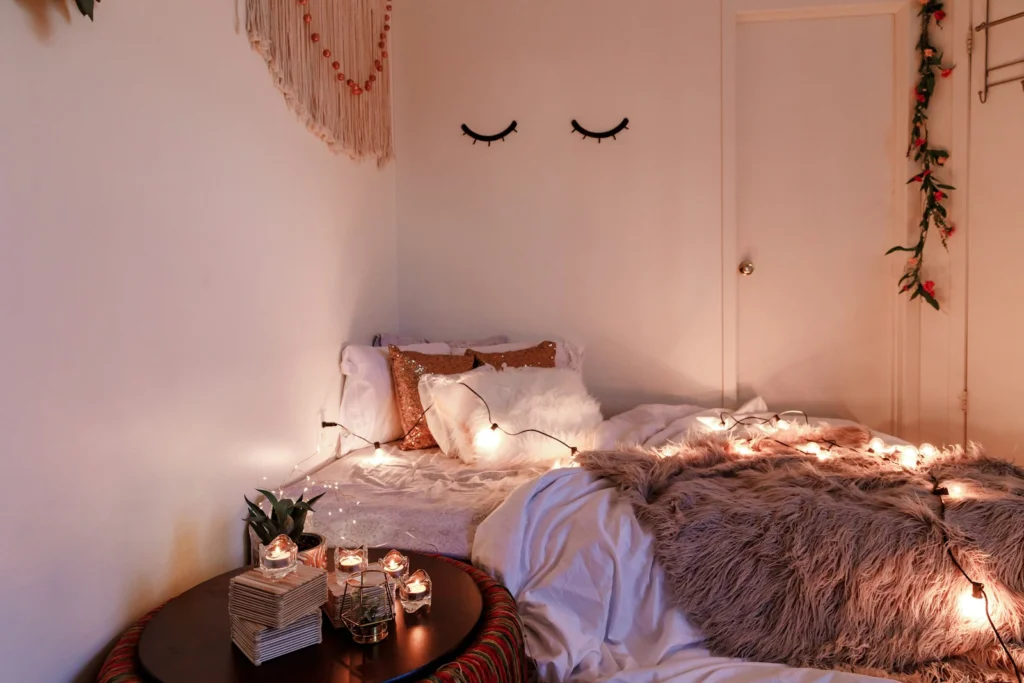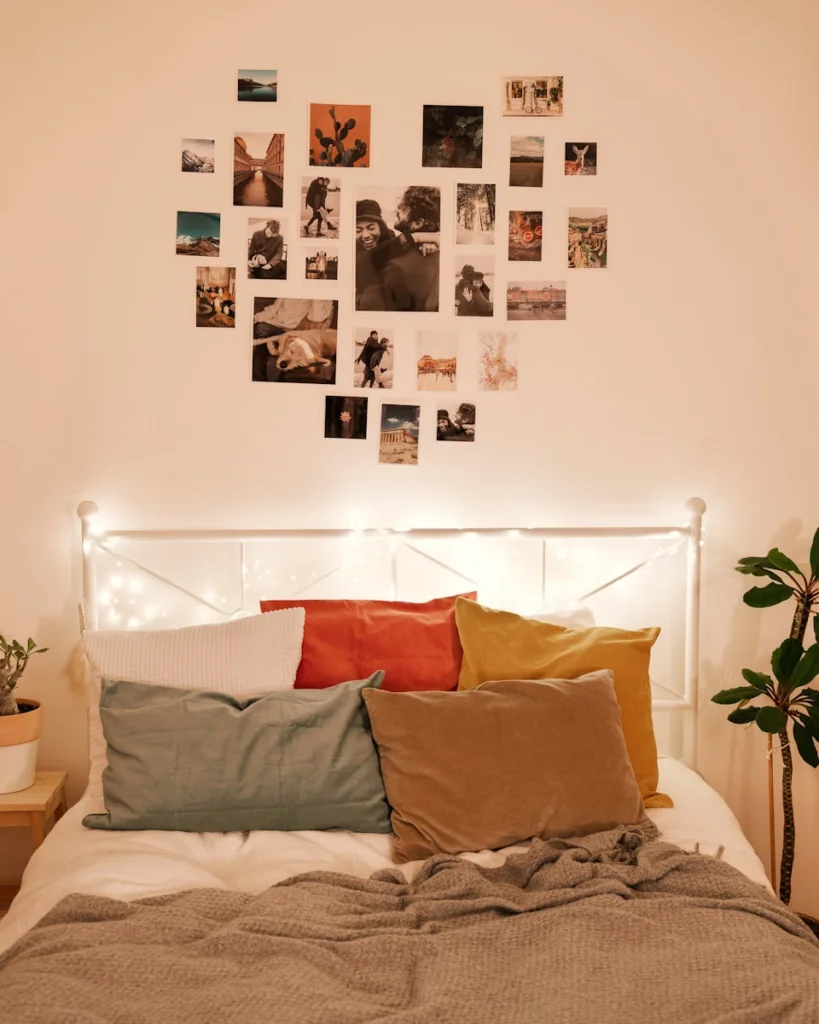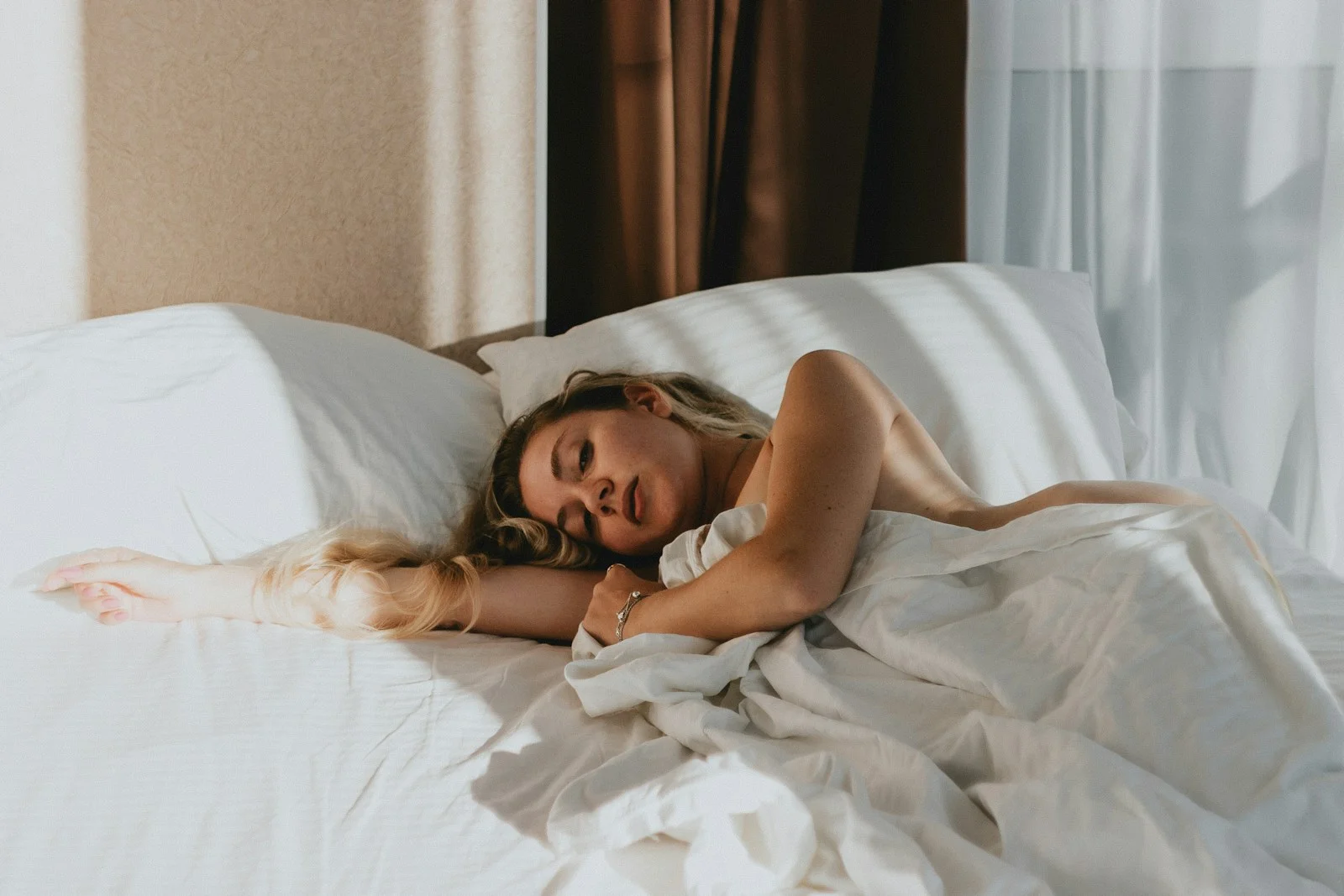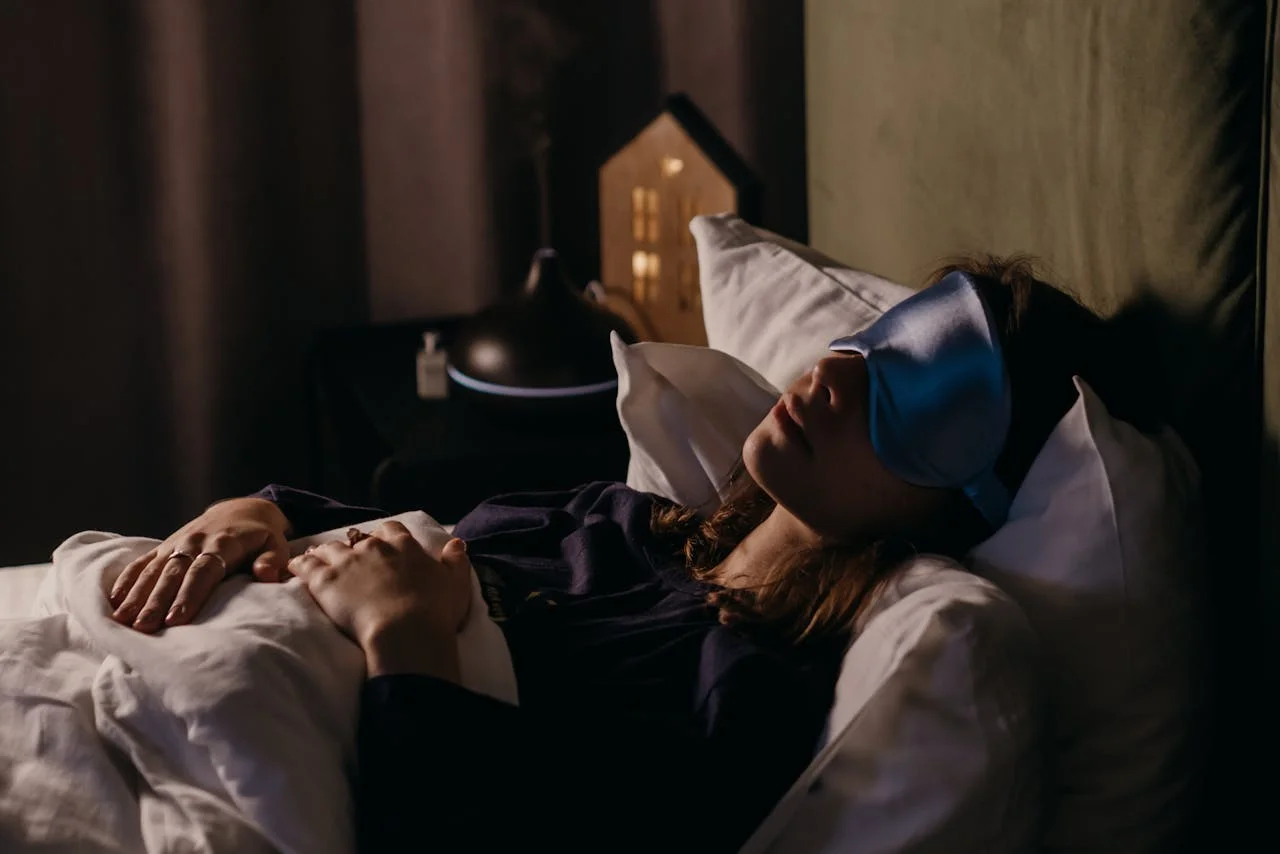
Did you know that your bedroom temperature affects your sleep quality more than your mattress choice? Most people set their thermostats too high, disrupting their body’s natural cooling process that signals sleep time. You’re probably missing out on deeper, more restorative rest simply because your room setup isn’t optimized for your biology. The good news? Small adjustments to fifteen key elements in your bedroom can transform restless nights into the rejuvenating sleep you’ve been craving.
Optimize Your Room Temperature for Deep Sleep
Most people don’t realize that getting your bedroom temperature just right can make or break your sleep quality. You’re in control of creating the perfect sleep environment, and temperature is your secret weapon for commanding better rest.
Master your sleep destiny by conquering bedroom temperature – it’s the game-changing factor most people completely overlook for quality rest.
Set your thermostat between 65-68°F for the ideal ambient temperature. Your body naturally drops its core temperature when preparing for sleep, so you’ll want to work with this biological process, not against it.
Install a programmable thermostat to minimize temperature fluctuations throughout the night – consistency is key to maintaining deep sleep cycles.
Don’t let your bedroom become too warm or cold. Both extremes will disrupt your sleep and leave you feeling groggy. Take charge by monitoring your room’s temperature and adjusting as needed. You’ll notice the difference immediately!
When your bedroom stays within this optimal range, you’ll experience faster sleep onset and deeper, more restorative sleep cycles throughout the night.
Create Complete Darkness With Blackout Solutions

When even the smallest amount of light creeps into your bedroom, it can sabotage your body’s natural melatonin production and keep you tossing and turning. You need complete darkness to achieve the deep sleep your body craves.
Blackout curtains and light blocking blinds are your secret weapons against sleep-disrupting light. These solutions block up to 99% of outside light, giving you total control over your sleep environment.
Maintaining dim lighting before bedtime helps prepare your body for the transition to sleep and supports your natural circadian rhythm.
| Light Source | Solution | Cost Range | Installation Time | Effectiveness |
|---|---|---|---|---|
| Street lights | Blackout curtains | $25-$150 | 30 minutes | 95-99% |
| Morning sun | Light blocking blinds | $40-$200 | 45 minutes | 90-95% |
| Electronics | Sleep masks | $10-$30 | Instant | 100% |
| Hallway light | Draft stoppers | $15-$25 | 10 minutes | 80-90% |
| Clock displays | Tape/covers | $5-$15 | 5 minutes | 100% |
Choose the Right Mattress for Your Sleep Style
Now that you’ve created the perfect dark environment, your mattress becomes the foundation that’ll make or break your sleep quality. You need to examine firmness level based on how you sleep—side sleepers typically need softer surfaces, while back and stomach sleepers require firmer support.
Next, evaluate spinal alignment needs by testing how your spine feels in different positions. A quality mattress should keep your spine naturally curved, not sagging or arched unnaturally. You’ll want to test mattresses for at least 10-15 minutes in-store.
Don’t rush this decision! You’ll spend roughly 2,500 hours per year on your mattress. Invest in a sleep trial period of 90-365 nights when possible. Your body needs time to adjust, and you deserve comfortable, restorative sleep that powers your success.
Just like your body requires personalized hydration based on individual factors, your sleep setup needs customization to match your unique physical requirements and lifestyle.
Select Pillows That Support Proper Spinal Alignment
While your mattress provides the foundation, your pillow acts as the essential bridge between your head and spine alignment. You’ll need to select pillow materials that match your sleep position and personal preferences to align spine adequately throughout the night.
| Sleep Position | Pillow Type | Height Needed | Material Recommendation |
|---|---|---|---|
| Side Sleeper | Firm Support | High (4-6 inches) | Memory foam or latex |
| Back Sleeper | Medium Support | Medium (3-4 inches) | Down alternative or hybrid |
| Stomach Sleeper | Soft Support | Low (2-3 inches) | Down or thin memory foam |
| Combination | Adjustable | Variable | Shredded foam or down |
Replace your pillow every 1-2 years, and invest $50-150 for quality materials. You deserve proper neck support that eliminates morning stiffness and headaches! Additionally, ensure your bedroom maintains a cool temperature between 60-67°F to promote your body’s natural drop in core temperature during sleep.
Invest in High-Quality, Breathable Bedding
Beyond your mattress and pillow, your sheets and blankets play a major role in temperature regulation and overall comfort. You’ll want to prioritize moisture wicking fabrics like bamboo, linen, or high-quality cotton that draw sweat away from your body. These materials prevent that clammy feeling that disrupts your sleep cycles.
Don’t overlook breathable mattress covers either – they’re your first line of defense against heat buildup. Look for covers with cooling gel inserts or mesh panels that promote airflow. You’re investing in your nightly recovery, so spend the extra $50-100 for premium bedding.
Replace synthetic materials that trap heat and moisture. Your body temperature naturally drops during sleep, and the right bedding supports this process. Choose thread counts between 200-400 for ideal breathability without sacrificing durability.
Quality sleep also depends on proper hydration throughout the day, as dehydration can cause your body to hoard excess fluid, leading to uncomfortable puffiness that disrupts your rest.
Remove Electronics and Blue Light Sources
Since your brain interprets blue light as daylight, those glowing screens trick your body into staying alert when you should be winding down. You’ll want to minimize exposure to electronics at least one hour before bedtime. Remove TVs, phones, and tablets from your bedroom entirely if possible.
If you must keep devices nearby, use blue light filters or glasses that block blue wavelengths. Most smartphones have built-in night modes that automatically reduce blue light after sunset. Position charging stations outside your bedroom to avoid temptation and eliminate those distracting notification lights.
Consider an old-fashioned alarm clock instead of your phone. This simple switch removes the biggest sleep disruptor from your nightstand! Your brain will thank you with deeper, more restorative sleep cycles. By eliminating blue light sources in the evening, you’ll support your circadian rhythm and enjoy better quality rest throughout the night.
Position Your Bed for Maximum Comfort and Flow

Your bed’s position dramatically affects both your sleep quality and how easily you move around your room. You’ll want to follow some basic placement rules that consider everything from wall positioning to ancient feng shui principles.
Let’s explore how proper bed placement, smart traffic flow, and strategic positioning can transform your bedroom into a sleep sanctuary! Position your bed within six feet of windows to take advantage of natural light for creating a more restful and energizing sleep environment.
Optimal Bed Placement Rules
While most people focus on mattress quality and thread count, the position of your bed within your room plays an equally pivotal role in achieving restful sleep. Your bed orientation directly impacts your comfort and energy flow throughout the night.
Strategic furniture placement follows specific principles that maximize your sleep quality. You’ll want to position your bed where you can see the door while lying down, creating a sense of security and control. This commanding position reduces subconscious stress that disrupts sleep.
Follow these ideal placement rules:
- Place your bed against a solid wall for stability and support
- Keep at least 18 inches of space on both sides for easy movement
- Avoid positioning your bed directly under windows or ceiling fans
- Situate your headboard against the longest wall possible
- Keep electronics and work materials away from your sleeping area
Feng Shui Positioning Tips
Ancient Chinese wisdom offers practical solutions for creating the perfect sleep sanctuary through feng shui principles. You’ll want to position your bed diagonally across from the door, giving you command of the room while maintaining distance from direct energy flow. This “commanding position” puts you in control of your space and sleep quality.
Implement decluttering strategies by removing items from under your bed and clearing nightstand surfaces. You’re creating space for positive energy to circulate freely around your sleeping area.
Install energy saving lighting with warm, dimmable bulbs to support your body’s natural rhythms.
Keep electronics away from your headboard and guarantee your bed has solid wall support behind it. These simple adjustments will transform your bedroom into a powerful sanctuary that promotes deeper, more restorative sleep.
Traffic Flow Considerations
Beyond feng shui placement, practical traffic flow around your bed dramatically impacts your daily comfort and sleep quality. You’ll want to analyze your current flow patterns and optimize traffic configurations for seamless movement throughout your space.
Strategic bed positioning creates natural pathways that don’t disrupt your partner’s sleep when you move around at night. Consider these essential flow patterns:
- Position your bed with at least 24 inches of clearance on both sides
- Keep pathways to the bathroom clear and obstacle-free
- Avoid placing furniture that blocks direct routes to closets
- Create designated walking zones that bypass the sleeping area
- Guarantee bedroom doors can open fully without hitting the bed frame
You’ll discover that thoughtful traffic configurations transform your bedroom into a sanctuary where movement feels natural and sleep remains undisturbed.
Add Plants That Improve Air Quality and Oxygen Levels

You’ll breathe easier and sleep better when you add the right plants to your bedroom sanctuary. The best air-purifying plants work around the clock to filter toxins and boost oxygen levels naturally.
Strategic placement of these green allies can transform your sleep space into a fresh, healthy haven that supports deeper rest! Just as fermented foods create beneficial environments in your digestive system by crowding out harmful pathogens, plants establish a healthier atmosphere in your bedroom by naturally filtering out toxins while you rest.
Best Air-Purifying Plants
While you sleep, certain plants work tirelessly to filter toxins from your bedroom air and boost oxygen levels naturally. You’ll gain tremendous air purifying benefits without sacrificing your busy schedule by choosing low maintenance varieties that thrive in bedroom conditions.
These powerhouse plants transform your sleep environment while requiring minimal effort:
- Snake Plant – Releases oxygen at night and tolerates low light perfectly
- Peace Lily – Removes ammonia, benzene, and formaldehyde from bedroom air
- Spider Plant – Eliminates carbon monoxide and other toxins effectively
- Aloe Vera – Produces oxygen while you sleep and needs watering monthly
- Rubber Plant – Filters harmful chemicals and grows well in dim lighting
You’ll breathe cleaner air within days of adding these natural air purifiers to your bedroom sanctuary.
Optimal Plant Placement Tips
Strategic placement of your air-purifying plants maximizes their oxygen-boosting power and creates the perfect sleep-friendly atmosphere. You’ll want to position your green allies where they’ll work hardest for you.
Place larger plants like snake plants or rubber trees in corners where they won’t obstruct your movement but can still filter air effectively. Your nightstand’s perfect for smaller specimens like pothos or peace lilies—they’ll release oxygen right where you breathe.
| Plant Location | Best Plants | Benefits |
|---|---|---|
| Nightstand | Pothos, Peace Lily | Direct oxygen flow |
| Floor corners | Snake Plant, Rubber Tree | Maximum air filtration |
| Window areas | Aloe Vera, Spider Plant | Natural light absorption |
These calming plant arrangements require minimal effort. Your low maintenance greenery will transform your bedroom into an oxygen-rich sanctuary within two weeks!
Control Noise With Sound-Absorbing Materials
How can you create a peaceful sleep sanctuary when outside noise keeps disrupting your rest? You’ll need to strategically utilize acoustic panels and incorporate sound dampening textiles throughout your bedroom. These materials absorb unwanted sounds before they reach your ears, giving you complete control over your sleep environment.
Transform your space with these powerful sound-absorbing solutions:
- Heavy curtains or blackout drapes that block both light and noise
- Thick area rugs that muffle footsteps and echoes
- Upholstered headboards that absorb sound waves
- Wall-mounted acoustic foam panels for maximum noise reduction
- Plush throw pillows and blankets that add extra sound dampening
You don’t need expensive renovations to achieve results. Start with one or two textile additions, then gradually build your sound barrier. Within weeks, you’ll notice dramatically improved sleep quality and fewer nighttime disruptions. For additional noise control, consider using a white noise machine or earplugs to eliminate any remaining sound disturbances that might penetrate your acoustic barriers.
Establish a Clutter-Free, Minimalist Environment
You’ll sleep better when your bedroom isn’t filled with distracting clutter and unnecessary items. Start by removing everything that doesn’t directly support your sleep, like work papers, exercise equipment, or random decorations scattered around.
Focus on keeping only the essentials—your bed, nightstand, and perhaps a dresser—to create that calm, minimalist space your mind craves for rest. This approach reduces mental friction that drains your energy and helps transform your bedroom into the peaceful sanctuary needed for quality sleep.
Remove Unnecessary Bedroom Items
While a cluttered bedroom might seem harmless, it’s actually sabotaging your sleep quality every single night. Your brain can’t fully relax when surrounded by chaos, making it harder to drift into deep, restorative sleep.
Take control by removing items that don’t belong in your sleep sanctuary. You’ll declutter unused furniture and minimize distracting décor that pulls your attention away from rest. Focus on keeping only what serves your sleep goals.
Remove these sleep disruptors immediately:
- Work-related materials and documents
- Exercise equipment and sports gear
- Excessive decorative items and knick-knacks
- Old magazines, books, and random papers
- Electronics that aren’t essential for sleep
Your bedroom should feel like a peaceful retreat, not a storage unit. Start with one category today and watch your sleep environment transform into the calming space you deserve.
Organize Essential Sleep Elements
Once you’ve cleared away the clutter, it’s time to thoughtfully organize what remains in your bedroom. Strategic placement of essential items will set circadian rhythm patterns and optimize light exposure for deeper sleep.
Position your bed away from direct sunlight while keeping nightstands within arm’s reach. Store sleep accessories in designated spots to maintain your minimalist environment.
| Sleep Zone | Essential Items | Organization Tip |
|---|---|---|
| Bedside | Lamp, water, book | Keep surfaces clear except essentials |
| Closet | Sleep clothes, linens | Dedicate one shelf for nighttime items |
| Window | Blackout curtains, timer | Install light-blocking solutions |
You’ll create a powerful sleep sanctuary when everything has its place. This organized approach eliminates decision fatigue and signals your brain it’s time to rest.
Use Aromatherapy and Essential Oils for Relaxation
Scents can transport your mind from the day’s stress straight into a peaceful, sleepy state. You hold the power to transform your bedroom into a relaxation sanctuary using calming scents and essential oils. Strategic aromatherapy placement creates an immediate sleep-inducing atmosphere that signals your body it’s time to unwind.
Essential oils for sleep mastery:
- Lavender oil – reduces anxiety and promotes deep sleep
- Chamomile – soothes nervous tension naturally
- Bergamot – lowers cortisol levels effectively
- Sandalwood – grounds your mind for rest
- Ylang-ylang – balances emotions before bed
Place a diffuser 3-4 feet from your bed, running it 30 minutes before sleep. You can also add drops to your pillow or enjoy a therapeutic massage with diluted oils. This simple strategy costs under $30 but delivers profound sleep improvements immediately.
Install Adjustable Lighting for Evening Wind-Down
Bright overhead lights at bedtime sabotage your body’s natural sleep preparation process by tricking your brain into staying alert. You’ll dramatically improve your sleep quality by switching to dimmable fixtures that give you complete control over your evening environment. Install adjustable brightness options like dimmer switches on existing overhead lights or add bedside lamps with variable settings.
Start dimming lights two hours before bedtime to signal your body it’s time to wind down. You can find affordable dimmer switches for $15-25 at most hardware stores, and they’re surprisingly easy to install yourself. Smart bulbs offer another excellent solution, letting you adjust brightness from your phone.
Create multiple lighting zones in your bedroom so you can customize the perfect ambiance for reading, relaxing, or preparing for sleep.
Maintain Proper Humidity Levels Year-Round

You’ll sleep much better when your bedroom’s humidity stays between 30-50% throughout the year. Too much moisture creates stuffiness and mold growth, while too little dries out your skin and airways.
Fortunately, you can easily control humidity levels with the right humidifier for dry winter months and a dehumidifier for muggy summer conditions.
Optimal Humidity Range
When humidity levels in your bedroom drift too far from the ideal range, you’ll notice the effects immediately through dry skin, scratchy throats, or that stuffy feeling that makes deep sleep nearly impossible. Take control of your sleep environment by targeting the sweet spot between 30-50% relative humidity.
This proper humidity balance creates the perfect conditions for restorative sleep while protecting your health. You’ll breathe easier, wake up refreshed, and maintain that ideal moisture content your body craves.
Key benefits of suitable bedroom humidity include:
- Reduced snoring and congestion for uninterrupted sleep
- Prevention of dry skin and irritated nasal passages
- Lower risk of respiratory infections and allergies
- Improved comfort without that sticky or parched feeling
- Better temperature regulation throughout the night
Humidifier and Dehumidifier Options
Achieving that perfect 30-50% humidity range requires the right equipment to handle seasonal changes and your home’s unique conditions. You’ll need different tools for effective moisture management throughout the year.
Cool-mist humidifiers work best for bedrooms, adding moisture without overheating your space. Ultrasonic models run quietly at $50-150 and cover 300-500 square feet. You can set them on timers for automatic humidity adjustment during sleep hours.
For excess moisture, portable dehumidifiers remove 30-70 pints daily and cost $200-400. Place them away from your bed to minimize noise. Smart models automatically maintain your target humidity level!
Hygrometers help you monitor levels accurately for under $20. You’ll know exactly when to switch between humidifying and dehumidifying modes, giving you complete control over your sleep environment.
Create a Designated Reading or Meditation Corner
Many people overlook the power of having a quiet corner in their bedroom that’s separate from sleep. You’ll transform your space into a true sanctuary by creating a cozy reading nook or comfortable meditation area. This dedicated zone helps your brain separate relaxation activities from sleep, improving your overall rest quality.
Choose a corner away from your bed and outfit it with essentials that support your evening wind-down routine:
- A comfortable chair or floor cushion for proper posture
- Soft lighting like a reading lamp or battery-powered candles
- A small side table for books, journals, or meditation tools
- Calming colors and textures that promote relaxation
- Storage basket for keeping supplies organized and accessible
You’ll create a powerful pre-sleep ritual that signals your body it’s time to shift toward rest.
Choose Calming Colors That Promote Restfulness
How powerfully does color influence your sleep quality? You’ll be amazed at how the right color palette transforms your bedroom into a sleep sanctuary. Choose soft blues, gentle greens, or warm neutrals like beige and cream. These colors naturally lower your heart rate and reduce stress hormones.
Avoid bright reds, oranges, or electric blues that overstimulate your mind. Instead, paint your walls in muted tones that create instant calm. You can add depth through soothing texture choices like linen bedding or a plush area rug.
Complement your color scheme with natural accent pieces such as wooden nightstands or stone lamps. These elements reinforce the peaceful atmosphere you’re creating. Recollect, your bedroom should feel like a retreat from the world’s chaos, not an extension of it!
Conclusion
You’ve got all the tools to transform your bedroom into a sleep sanctuary! Recall, Rome wasn’t built in a day, so tackle these changes gradually. Start with the basics like temperature and lighting, then work your way through the list. Your body will thank you when you’re getting deeper, more restorative sleep. Small changes lead to big improvements in how you feel each morning. Sweet dreams await!





Leave a Reply